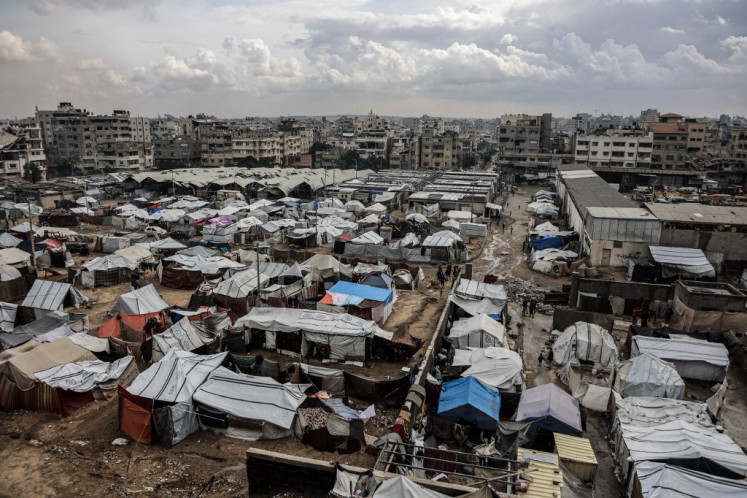Popular Reads
Top Results
Can't find what you're looking for?
View all search resultsPopular Reads
Top Results
Can't find what you're looking for?
View all search resultsMaps mark borders, and yet always lies
In the early 1990s, Goenawan Mohamad wrote that God might not agree on one single map that men had created
Change text size
Gift Premium Articles
to Anyone
In the early 1990s, Goenawan Mohamad wrote that God might not agree on one single map that men had created.
Maps continually change, especially when it comes to borders. New lines are needed to mark the emergence of new autonomous entities, while some other lines disappear because of the fusion of two or more territories.
Most of the time, border lines separating two entities (countries, provinces, districts, villages, etc) are imaginary. While some borders are marked by walls such as the Berlin Wall that fell in 1989, most borders do not physically exist. They can be marked by pillars even these can only be limited in density.
Alternatively, borders are shown on a map, represented by lines distinguishing one area from another.
Maps are legal documents depicting borders between countries or other entities.
In maritime areas, where physical markers are almost impossible to install, maps are essential to depict borders. In the context of independent states, maps are important to mark the limits of sovereignty and jurisdiction.
A map is a cartographic product presenting the Earth’s surface, or part of it. Prior to drawing maps, surveys for data collection are required. While in the past surveys were terrestrial in nature, nowadays satellite and aircraft are involved in capturing the appearance of the Earth’s surface.
The development of technology has significantly changed the way surveyors collect data, but one thing remains the same: A map is a flat representation of the Earth’s curved surface.
Undoubtedly, distortion is inevitable. Imagine an egg shell painted with a human face and then flattened, it would crack and the human face would certainly distort. No single map can represent the real truth of the Earth’s surface. Every map, in one way or another, lies.
However, we need a representation of the Earth’s surface that we can conveniently see on a single medium. This is where maps come in. In defining the areas of sovereignties and jurisdictions, maps are essential.
Knowing that all maps lie, there has to be a common understanding among relevant parties concerning the specification of maps. Yes, we can use maps but we do not have to believe every single thing on maps that may incorrectly represent the Earth’s surface, due to technical limitations.
In relation to sovereignty disputes, maps play an important role. For example, a map can really make a difference in deciding whether or not a disputed island, for example, can be awarded to one party or another.
In the dispute over Sipadan and Ligitan islands between Indonesia and Malaysia, for example, there was a serious investigation to identify whether or not those two islands were depicted on the maps drawn up by Indonesia (Dutch) or Malaysia (British).
With regard to the border dispute, a map may worsen existing conflict. The way Google Maps depicted the border between China and India in 2009, for example, sparked debate and controversy.
A disputed area between the two states called Arunachal Pradesh was depicted to be part of China in a localized Chinese Google Maps, while the same area was portrayed to be in the Indian side of borderline in a localized Indian Google Maps.
Recently, Google Maps was also accused of contributing to a border dispute between Nicaragua and Costa Rica.
Nicaraguan troops seemed to rely on an allegedly inaccurate Google Maps in conducting its activities around San Juan River located in the border area between Nicaragua and Costa Rica.
While it is true that Google Maps has been widely accepted as a reliable source for many purposes, it is intriguing to know that the map is also relied upon by a national military army for a sensitive operation in a border area.
A country usually has its own recognized map depicting border-lines and border areas based on its official claims/position.
With regard to the aforementioned inaccurate Google Maps, Costa Rica insisted Google revise that part of its map, while Nicaragua requested the map not be altered.
This indicates that both parties consider maps important when it comes to sovereignty and border disputes. Both seem to believe that a public-domain map, like Google Maps, really matters to support their sovereignty claims.
The case of Indonesia and its neighbors is similar when it comes to the use of maps for sovereignty.
When there was an incident in the waters off Tanjung Berakit involving Indonesian officials and Malaysian fishermen in August 2010, both countries based their position on maps depicting their maritime claims. Malaysia used a map it published in 1979 and Indonesia relied upon its most up-to-date map of 2009.
For both countries, a map is important to support their claims, and would be essential during negotiations to settle boundary lines between them. Even though it is not everything, a map is crucial when it comes to resolving sovereignty and border disputes.
To resolve a dispute, maps are important because they chronicle the history of border claims. On the other hand, an existing map might need to be altered when an agreement over a border or sovereignty dispute has been achieved.
Maps are part of the history of sovereignty and jurisdiction disputes. Map makers should realize that their products are more than merely points, lines and areas drawn on a piece of paper.
The writer is a lecturer at the Department of Geodetic Engineering, Gadjah Mada University. This is his personal opinion.










